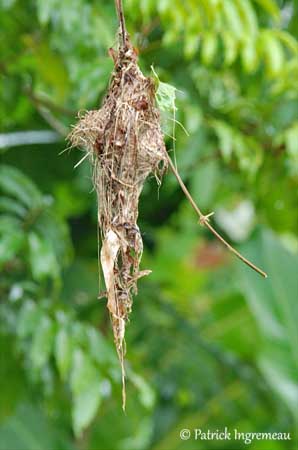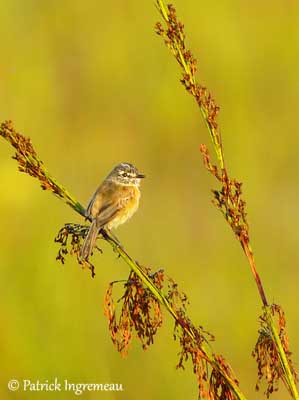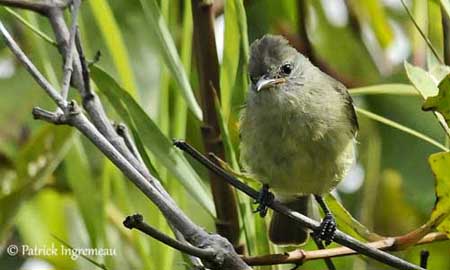
Text by Nicole Bouglouan
Photographers:
Marc Chrétien
MURINUS
Alfredo Colón
Puerto Rico Wildlife
Maxime Dechelle
LEPAPARRAZO
Jean Michel Fenerole
Photos d’Oiseaux du monde
Steve Garvie
RAINBIRDER Photo galleries
Tom Grey
Tom Grey's Bird Pictures
Patrick Ingremeau
TAMANDUA
Philippe and Aline Wolfer
OISEAUX D'ARGENTINE
Sources:
HANDBOOK OF THE BIRDS OF THE WORLD Vol 9 - by Josep del Hoyo - Andrew Elliot - David Christie - Lynx Edicions - ISBN: 8487334695
A GUIDE TO THE BIRDS OF MEXICO AND NORTHERN CENTRAL AMERICA by Steve N. G. Howell, Sophie Webb - Oxford University Press - ISBN: 0198540124
A GUIDE TO THE BIRDS OF COLOMBIA by Steven L. Hilty and William L. Brown - Princeton University Press – ISBN 069108372X
TYRANNIDAE FAMILY
Tyrants-Flycatchers
Subfamily Elaeniinae
Group Elaeniini
The species of this subfamily are largely tropical in terms of latitude and elevation. Almost half of the members are tyrant-flycatcher species. They are small to medium-sized birds, with greenish-olive colours and small, rounded or needle-like bill. They usually forage and hunt in habitats with dense vegetation.
There are some exceptions such as Northern and Southern Beardless Tyrannulets of genus Camptostoma. They are drab-coloured tyrannulets with slight crest and long, sharply pointed bill with curved upper mandible. These vireo-like tyrannulets lack the rictal bristles, giving these birds their name “beardless”.

Southern Beardless Tyrannulet
Camptostoma obsoletum
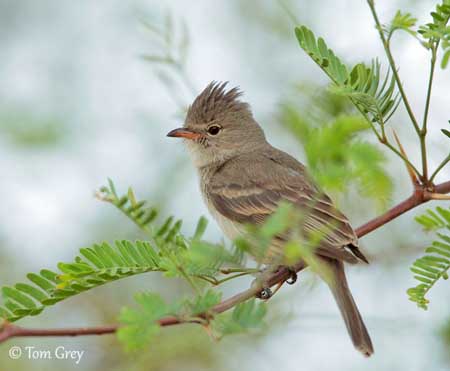
Northern Beardless Tyrannulet
Camptostoma imberbe
There are the only Elaeniini species with a distribution extending north of the Mexico-USA border where they are found in typical “Mexican” habitats.
The genus Ornithion is closely related to the previous due to some morphological features, but they differ in nesting behaviour, and especially in the nest building.
At the southern extreme, some species of genus Elaenia breed southwards into temperate lowland habitats.
The White-crested Elaenia (Elaenia albiceps) of the race E.a. chilensis breeds in Andes, as far as the lowlands of Tierra del Fuego. The breeding grounds of the Small-billed Elaenia (Elaenia parvirostris) reach the regions of NE Argentina (S to Buenos Aires) and Uruguay.
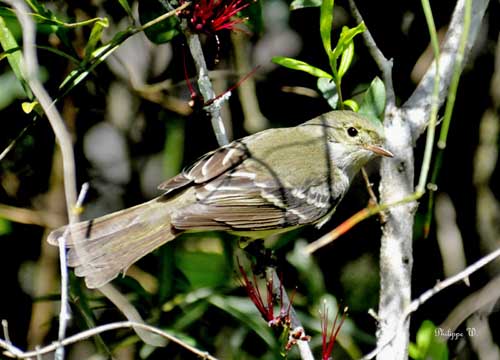
Small-billed Elaenia
Elaenia parvirostris
In the montane genera Mecocerculus and Anairetes, several species reach Argentina and Central Chile, and as far as the Juan Fernández Islands.
With the genus Serpophaga, these three genera are considered as closely related, in spite of different habitat types.
Similar to Warblers, the Mecocerculus occur in the temperate Andean cloud forest.
The “tit-tyrants” of genus Anaraites frequent temperate or arid scrubby habitats, mainly in the Andes. Their name comes from the conspicuous crest and their active perch-gleaning foraging behaviour reminiscent of that of several true tits and titmice (Paridae family).
The tyrannulets of genus Serpophaga are related to rivers and streams. They hunt by sallies from boulders or muddy banks, glean for preys on rocks or overhanging vegetation, or even from the water surface.
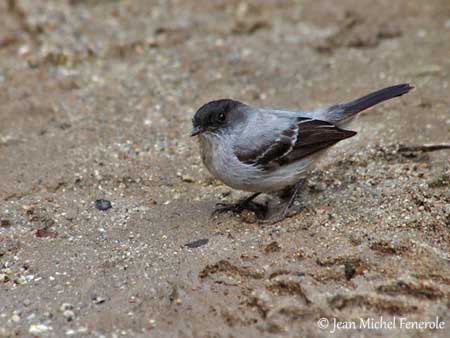
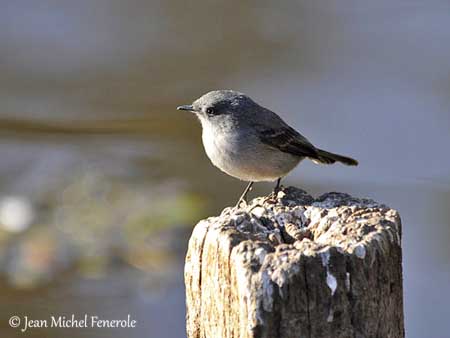
The subfamily Elaeniinae is rich in species which conform to the stereotype “little green flycatcher”. The basic plumage is greenish-olive above, and pale to yellowish below, with the breast washed olive and double wing-bars on uppperwing. The head has indistinct facial markings and occasionally shows a concealed crown patch only visible when the crest is erected, whereas others in genus Elaenia show slightly elongated crest feathers often used while calling and displaying. The bill varies in shape according to the genera, from small or slender to broad, flattened and spatulate.
The sexes are similar except a few tody-tyrants of genus Poecilotriccus.
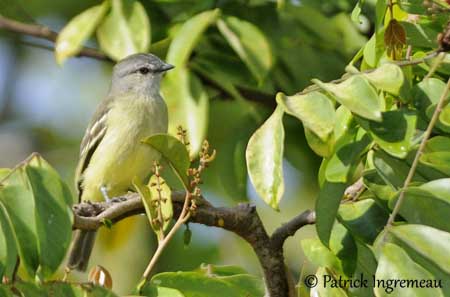
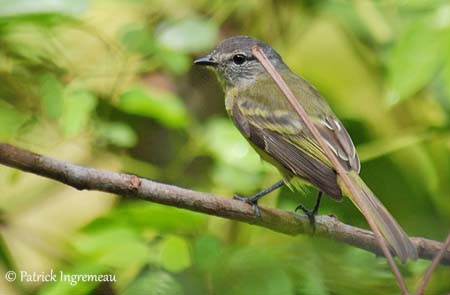
The genus Elaenia is found in forest and scrubby habitats, from Central America S to central Argentina. They hunt by sallies for preys inside the vegetation or over it, and also feed regularly on fruit.
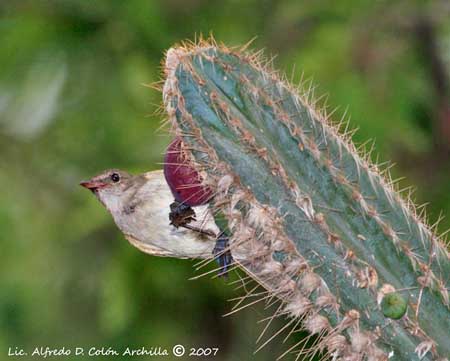
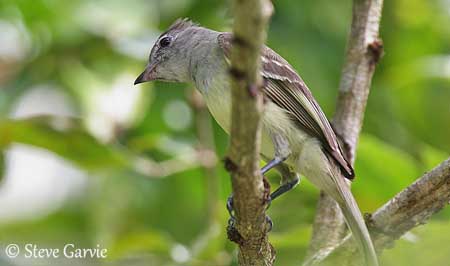
The two antpipits of genus Corythopis are exclusively terrestrial birds, including for nesting.
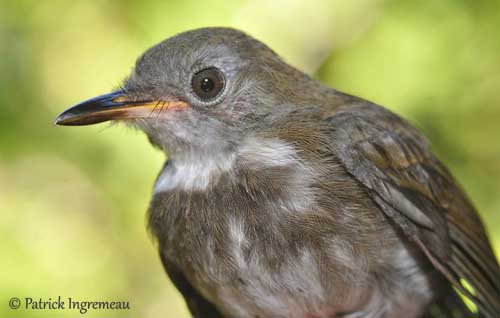
Ringed Antpipit
Corythopis torquatus
Several other genera such as Pseudotriccus, spend their whole lives in the dense vegetation, within only some centimetres on the ground.
Some peculiar criterions are found in the Sharp-tailed Tyrant (Culicivora caudacuta) of genus Culicivora. The tail of this tiny bird has ten stiffened rectrices, reminiscent of the Synallaxis spinetails in the family Furnaridae. This species if usually restricted to grassland and marshy habitats.
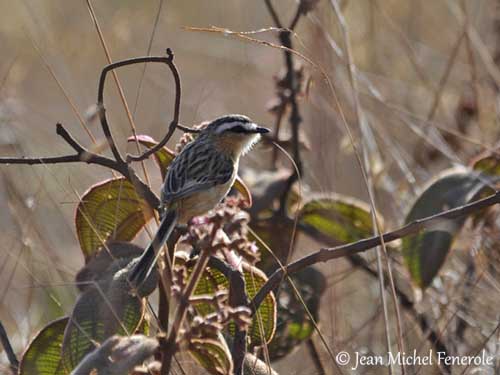
Sharp-tailed Tyrant
Culicivora caudacuta
The wagtail-tyrants of genus Stigmatura often carry the tail cocked over the back while foraging in the low vegetation and often near water.
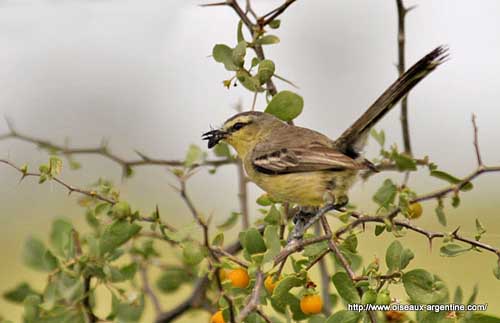
Greater Wagtail-Tyrant
Stigmatura budytoides
The Many-coloured Rush-Tyran (Tachuris rubrigastra) has slender bill, short crest and long legs and feet adapted to its marshy habitats. It is restricted to dense rushes and reeds. Its colour and behaviour make it very different of other Tyrannidae species.
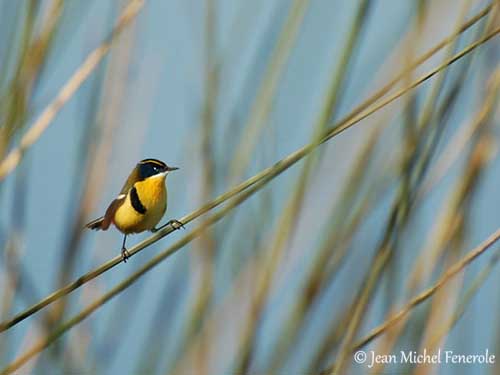
Tachuris rubrigastra
All there small birds hunt by performing frequent and rapid sallies from perches such as vegetation, rocks, branches, reeds and several other supports. They primarily feed on insects, but large numbers are taking fruit and berries too.
With a few exceptions, the species included in the subfamily Elaeniinae are fairly similar in appearance, habitat types and foraging behaviour, but their breeding and nesting habits vary according to the species.
The Tyrannidae species of North and Central America breed between March and July, whereas those of northern South America and Peruvian Andes breed from January to June. The species living farther south, in the southern Andes and south of the equator, breed from August to January.
Usually, these birds raise only a single brood.
Their predominant social system in all parts of the range is monogamous pair-bonds and each pair defends its territory.
However, in the subfamily Elaeniinae, the members of genus Mionectes are the only ones known to exhibit lek behaviour.
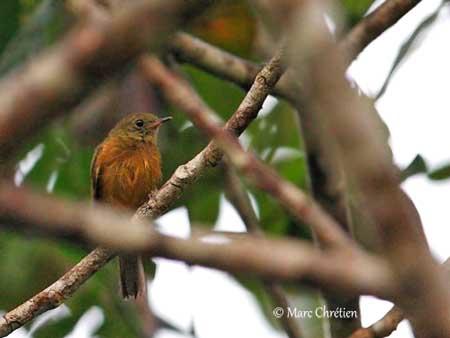
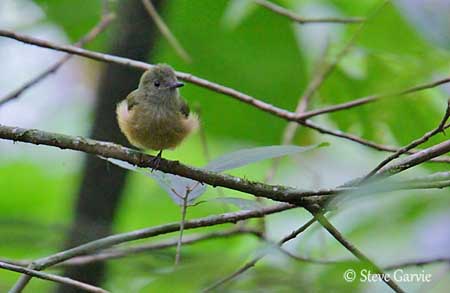
Throughout the breeding season, males sing and display in loosely defined areas. Others display solitary. Some of them named “floaters” move through the forest and can enter displaying males’ territories. Females visit males at leks. But aggressive encounters between males are very common. The songs play an important role during these interactions.
Many species engage in conspicuous display behaviour, in association with courtship within a pair, or disputes between males. Numerous species have a concealed crown patch, only visible when the short crest is erected. This patch can be yellow, orange or red according to the species.

Yellow-crowned Tyrannulet - Tyrannulus elatus
These coloured feathers are raised during displays, both vertically and sometimes laterally, while facing the mate or the opponent. Spreading, fanning and fluttering of the wings accompanied by active vocalizations are important part of displays.
The smaller species in Elaeniinae such as the genera Phyllomyias, Zimmerius, Pogonotriccus and Phylloscartes utter twittering, peeps and trills.
The genus Elaenia and the eleniaes of genus Myiopagis give single, short, melodious phrases such as the soft “pil-dooeet” of the Forest Elaenia.
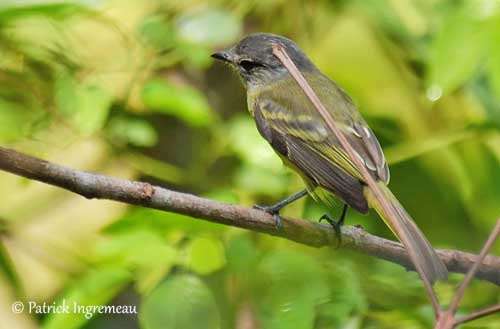
Forest Elaenia
Myiopagis gaimardii
Almost all the Tyrannidae species utter distinct dawn songs, given from perch where the bird remains motionless while singing during 10 to 30 minutes.
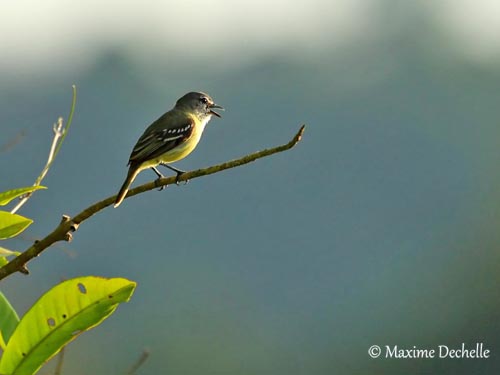
White-lored Tyrannulet
Ornithion inerme
All members of genus Elaenia build neat open cups, usually concealed in dense foliage. The Yellow-bellied Ealenia does this type of nest.
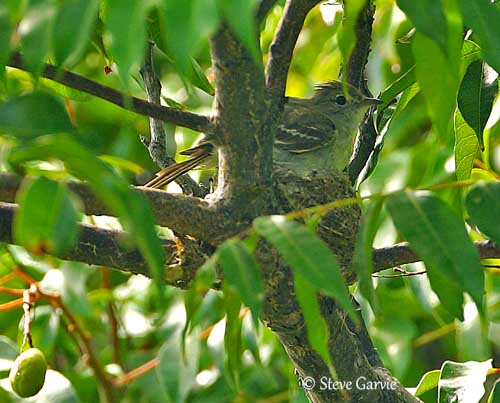
Yellow-bellied Elaenia
Elaenia flavogaster
In contrast, the nest of the antpipits of genus Corythopis is an oven-like, domed cup, placed on leaf detritus on the forest floor. There is a side entrance and three layers, the cup, the lining and an outer covering, that is unique in the Tyrannidae family.
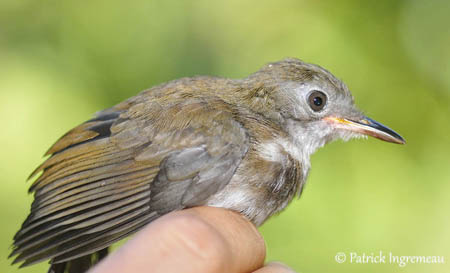
Ringed Antpipit
Corythopis torquatus
The two beardless tyrannulets of genus Camptostoma build an ovoid nest concealed in the low vegetation, or tucked into bromeliads.
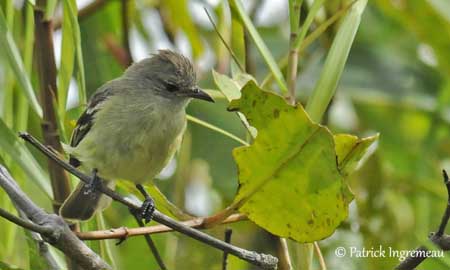
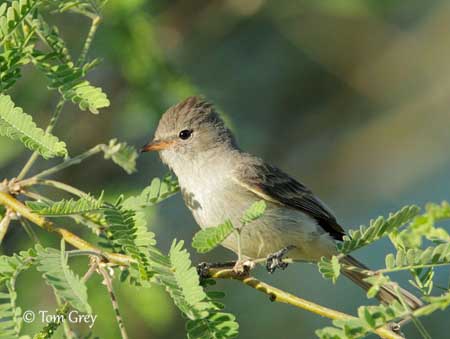
The tyrannulets of genus Ornithion build a small open cup concealed in clumps of leaves in tree.
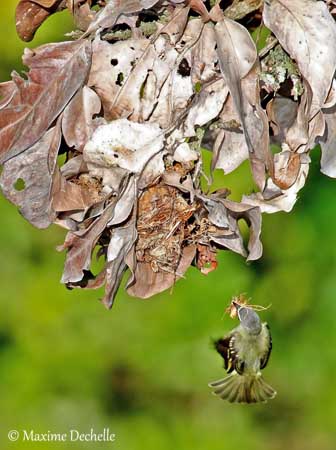
White-lored Tyrannulet
Ornithion inerme
Spectacular nests are built by the genera Mionectes and Leptopogon. This is a long, pendent nest with an enclosed chamber and a roofed side entrance. These nests are well camouflaged among the vegetation and are usually suspended from tips of narrow hanging branches or fallen tree within a ravine, even over rocky streams.
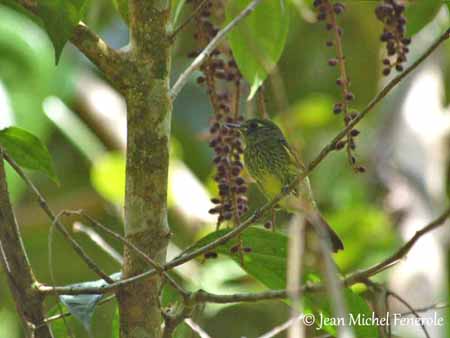
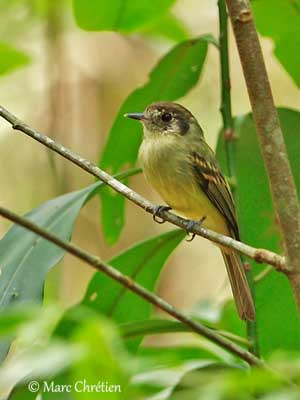
The bright Many-coloured Rush-Tyran builds a very distinctive deep, tight, cone-shaped nest, attached by the side to a single reed and usually above the water. It uses wet pieces of reed leaf which after drying, make the nest very strong.
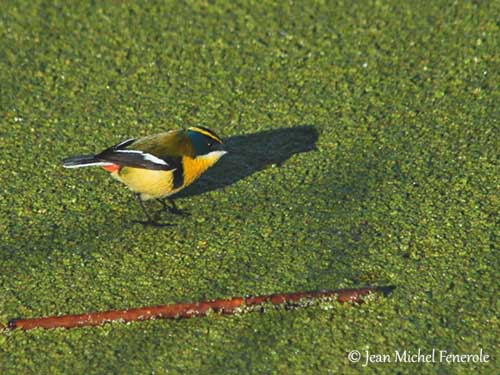
Tachuris rubrigastra
Among the Tyrannidae, the female is more active than the male. She often builds the nest alone and incubates the eggs. The clutch size varies from 2-6 eggs to 2-4 eggs in the most tropical species. The incubation lasts 12-16 days in both North and South America, but can reach up to 23 days among some of the smaller species of Central and South America which build hanging nests.
The chicks are usually fed by both parents and the male here plays a more active role. The young fledge between 12 and 24 days after hatching, but most of them leave the nest at 14-17 days. They remain hidden in the vegetation while uttering loud begging calls. They often roost together in a row, in physical contact, perched on the branch.
The juveniles may spend several months with their parents, but tyrant-flycatchers are not known to exhibit co-operative breeding.
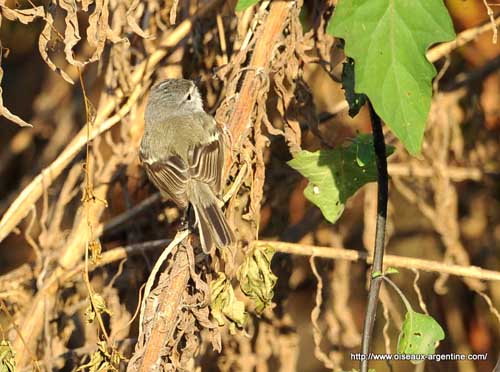
White-crested Tyrannulet - Serpophaga subcristata
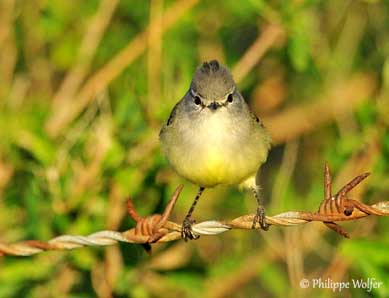
Group Platyrinchini
This tribe includes about 50 species of small-bodied flycatchers classified into 8 genera known as tody-tyrants, pygmy-tyrants, tody-flycatchers, bentbills and flatbills.
These tiny flycatchers usually have a long, spatulate-shaped, very large bill regarding the small body. The tarsi are long and slender too.
They may show minor differences in plumage and bill shape, but all members of this tribe are replicas of one another in both morphology and behaviour. They feed on insects caught by short upward strikes from twigs.
Each species often occurs in a different micro-habitat, from the upper canopy to the dark mid-storey inside the forest such as the White-eyed Tody-Tyrant (Hemitriccus zosterops), whereas the Spotted Tody Flycatcher (Todirostrum maculatum) occupies seasonally flooded leafy thickets close to rivers.
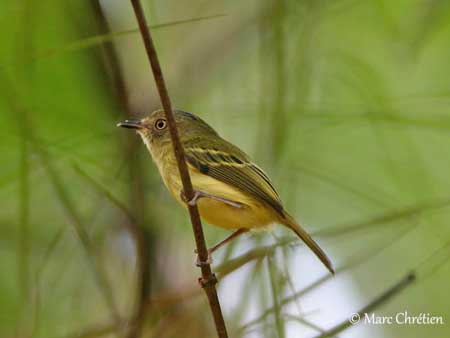
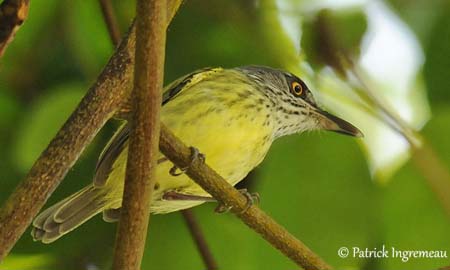
The Rusty-fronted Tody Flycatcher (Poecilotriccus latirostris) lives in impenetrable undestorey habitats, while the Pearly-vented Tody-Tyrant (Hemitriccus margaritaceiventer) frequents shrubby pastures and lower growth of deciduous woodland.
Other species of pygmy-tyrants occupy different types and size of bamboo strands of genus Guadua.
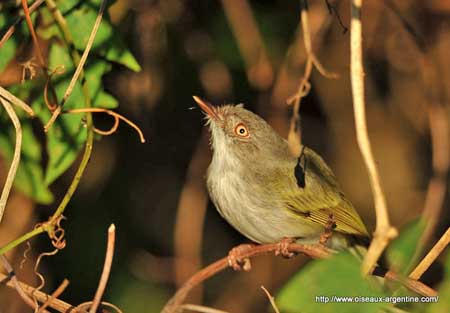
The world’s smallest passerine birds are included in the genus Myiornis. They have tiny, rounded wings and very short tail. They move with very rapid wing-beats in hovering-type of flight, and appear very similar to medium-sized Coleopterans.
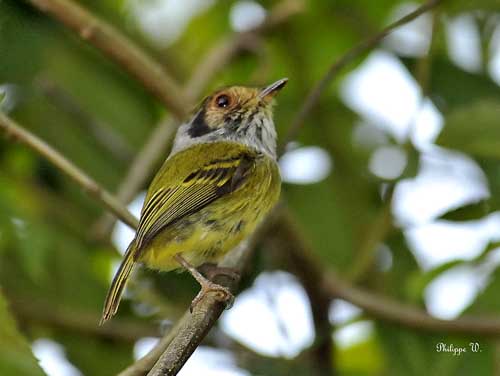
Eared Pygmy Tyrant
Myiornis auricularis
The genus Lophoticcus contains four species which have peculiar, laterally orientated crest. They mainly occur in humid forest, swamp forest, second growth or tall savannah woodland.
The only member of the genus Atalotriccus is closely related to the previous, but it lacks the peculiar crest. This one occurs in scrub and dry woodland.
The Poecilotriccus species show spectacular plumage pattern with bushy chestnut crown, yellow wing stripe and black breastband. Several birds of the genus Todirostrum with similar plumage features have been transferred to Poecilotriccus.
The largest genus is Hemitriccus with more than 20 species. They are small, brownish-olive to greenish-olive birds, with variable olive streaking on breast, and rusty wash on head and throat. They have long and slightly spatulate bill.
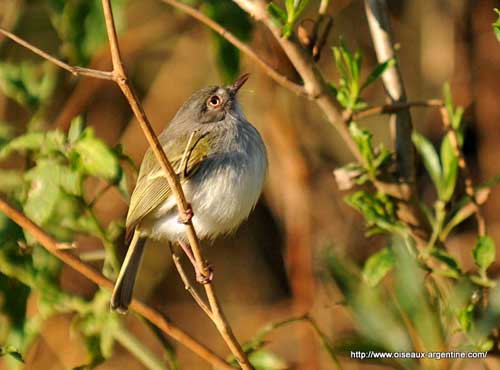
The genus Todirostrum includes small blackish and yellow birds. They have very long bill with almost squared tip producing spatula-like shape.
They forage by upward strikes and have restricted repertoire of calls with only some nasal “tic” notes and chirps, which is unusual in the Tyrannidae family.
They frequently perform some displays such as to hold the wings dropped and the tail cooked vertically over the back, while moving sideways along a perch and uttering series of sharp “tic”.
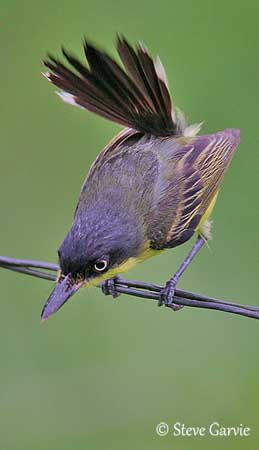
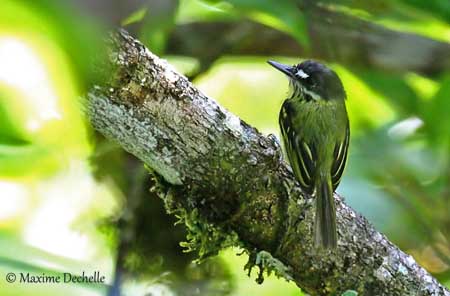
The flatbills are included in Rhynchocyclus and Tolmomyias genera. They have distinctive, stout, laterally swollen, shovel-shaped bill.
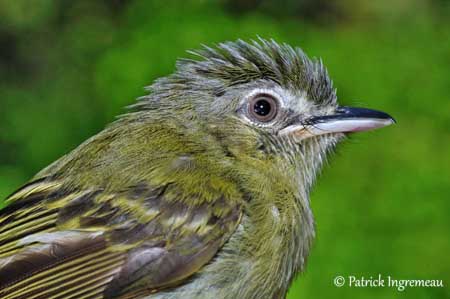
Yellow-olive Flycatcher
Tolmomyias sulphurescens
They live in forest and dense shrubby woodland, and share some unique behaviour such as to use their pendent nests as temporary roosts outside the breeding season.
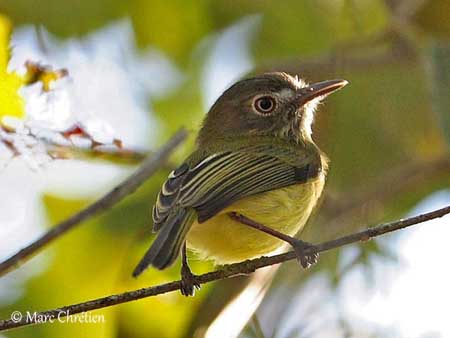
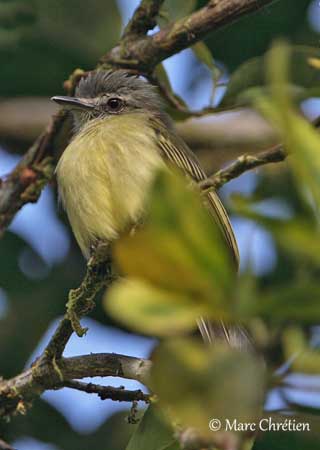
The fairly similar Platyrhyncus species named “spadebills” due to the broad, flat bill, build delicate cup-shaped nest at the fork of a branch. They inhabit the dark forest understorey. They perch on bare twigs from which they perform explosive upward sallies to catch insects on the underside of the leaves.
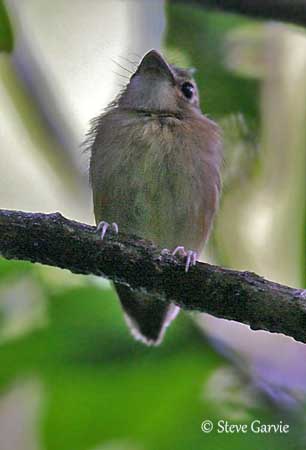
Stub-tailed Spadebill
Platyrhynchus cancrominus
In the genus Onychorhynchus, the Royal Flycatcher (Onychorhynchus coronatus) is a slender, buffy-brown flycatcher with short legs and long, flattened bill surrounded by conspicuous rictal bristles, the longest in the family. It shows an elongated, fan-shaped crest, scarlet in male and yellow-orange in female, with iridescent violet-blue tips. During the displays, the crest is fanned out vertically and laterally, resembling a peacock tail with bright colours.
These displays occur both in courtship and during intra-sexual competitions or territorial encounters.
The bird lives in the dark forest understorey. It builds an elaborated camouflaged hanging nest of about two metres in length.
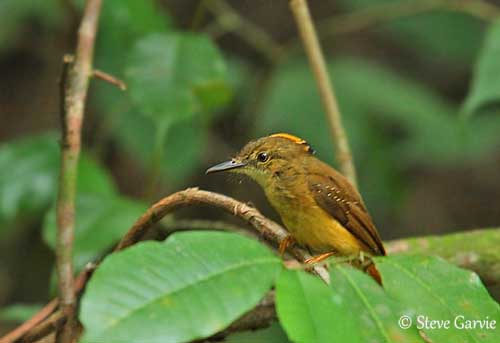
Royal Flycatcher
Onychorhynchus coronatus
The members of the tribe Platyrinchini build purse-like, pendent nests with a side entrance that appears to be a universal trait among them. The tody flycatchers place sometimes these structures near active nests of paper wasps.
The pendent nests of Tolmomyias and Rhynchocyclus are tightly woven with wines. This is a ball-like main pouch and a woven tube descending from the top and forming a side entrance. It is placed 10-20 metres above the ground, hanging from outer branch in exposed tree.
Incubation and fledging periods are fairly similar to those of Elaeniini, as the nesting behaviour, except for the Royal Flycatcher which does not take part in feeding the young, but it is present for nest-guarding throughout the nesting cycle.

